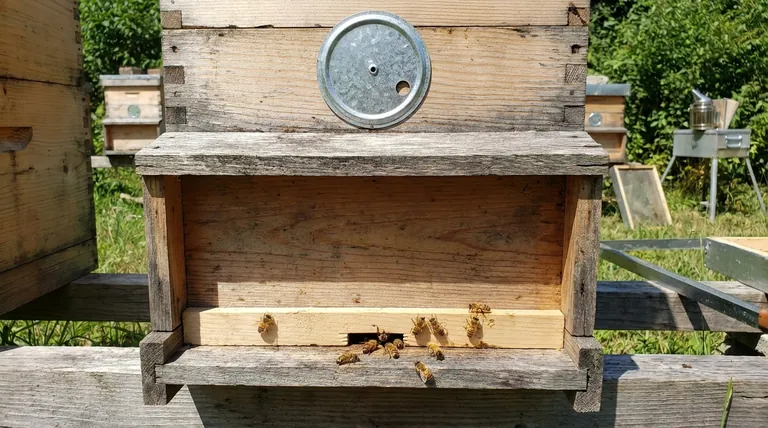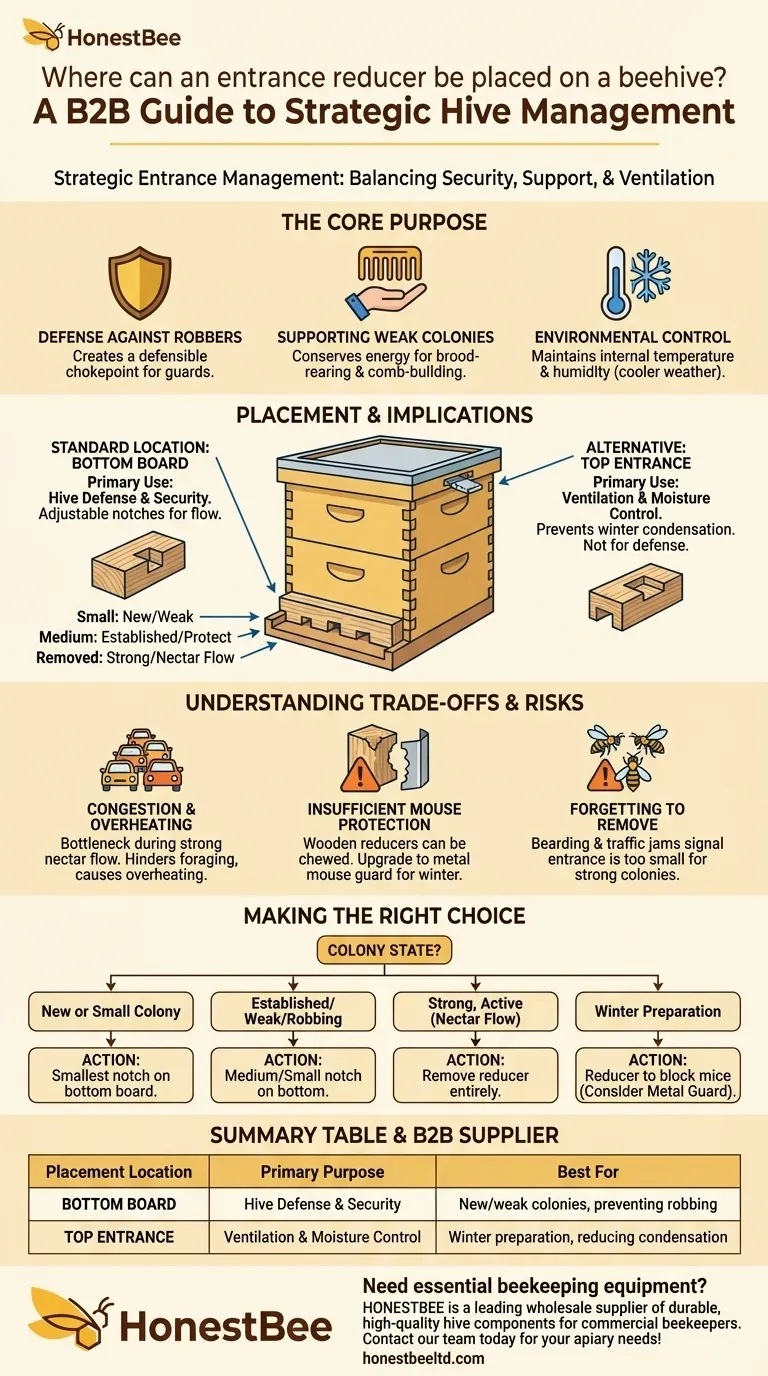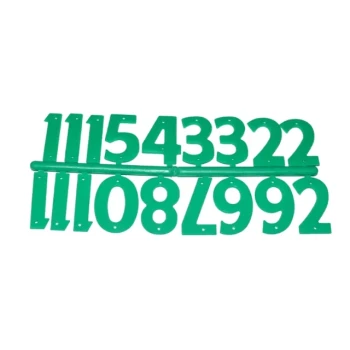An entrance reducer is a simple wooden block most commonly placed on the bottom board of a beehive, right at the main entrance. While this is the standard location for hive defense, a reducer or a modified upper entrance can also be placed at the top of the hive to serve different purposes, primarily related to ventilation.
The core principle is not simply to block the entrance, but to strategically match the size of the opening to the colony's current strength and ability to defend itself from outside threats.

The Core Purpose of an Entrance Reducer
An entrance reducer is a fundamental tool for managing a colony's security and stability, especially during its more vulnerable stages.
Defending Against Robbers
A wide-open entrance is difficult for a small population of bees to guard. A reducer shrinks this opening, creating a defensible chokepoint where a few guard bees can effectively fend off robber bees from other hives trying to steal honey.
Supporting New or Weak Colonies
When a new package of bees is installed or a colony is weakened by disease or a poor season, its population is low. Reducing the entrance allows the colony to focus its energy on brood-rearing and comb-building rather than dedicating excessive resources to defense.
Aiding in Environmental Control
A smaller opening helps a small cluster of bees maintain the hive's internal temperature and humidity more efficiently. This is especially important during cooler weather or overnight.
Placement and Its Implications
Where you place the reducer depends entirely on your management goal. The vast majority of the time, it will be used at the bottom entrance.
The Standard Location: The Bottom Board
This is the primary and most frequent use for an entrance reducer. The small wooden block fits snugly between the bottom board and the first hive body (brood box).
Most reducers are designed with two different notch sizes. You can rotate the block to provide a small opening, a medium opening, or, by removing it, the full entrance.
The Alternative: A Top Entrance
Placing a reducer or a similar device at the top of the hive is not for defense against robbers. A top entrance is typically used to provide an alternate exit for bees and, more importantly, to allow moisture to escape during the winter.
This prevents condensation from building up and dripping down on the winter cluster, which can be fatal. It is a ventilation tool, not a primary defensive one.
Understanding the Trade-offs
While essential, using an entrance reducer at the wrong time can hinder a colony's progress.
Risk of Congestion and Overheating
For a strong, booming colony during a heavy nectar flow, a reducer acts as a bottleneck. It creates a traffic jam for foraging bees, slowing honey production and potentially causing the hive to overheat from poor ventilation.
Insufficient Mouse Protection
During fall and winter, a reducer helps keep mice from nesting inside the warm hive. However, determined mice can and will chew through a standard wooden reducer. For robust winter protection, a dedicated metal mouse guard is a far more reliable solution.
Forgetting to Remove It
A common mistake is leaving a reducer in place after the colony has become strong. If you see bees bearding on the front of the hive or creating traffic jams, it is a clear sign the entrance is too small for their needs.
Making the Right Choice for Your Hive
Apply this tool based on direct observation of your colony's needs.
- If you are installing a new or small colony: Use the smallest notch on a bottom board reducer to give the bees maximum defensive advantage.
- If your hive is established but showing signs of weakness: Use a medium or small notch to help the existing bees protect their resources from robbers.
- If your colony is strong and active during a nectar flow: Remove the reducer entirely to maximize foraging efficiency and hive ventilation.
- If you are preparing for winter: Use a reducer to block mice, but strongly consider upgrading to a dedicated metal mouse guard for superior protection.
Properly using an entrance reducer is a simple yet powerful way to align the hive's environment with the colony's strength.
Summary Table:
| Placement Location | Primary Purpose | Best For |
|---|---|---|
| Bottom Board | Hive Defense & Security | New/weak colonies, preventing robbing |
| Top Entrance | Ventilation & Moisture Control | Winter preparation, reducing condensation |
Need the right entrance reducer or other essential beekeeping equipment for your apiary? As a leading wholesale supplier, HONESTBEE provides commercial beekeepers and distributors with durable, high-quality hive components designed for optimal colony health and management efficiency. Let us help you equip your operation for success. Contact our team today to discuss your supply needs!
Visual Guide

Related Products
- Multi-Functional Rotary Hive Entrance Disc for Beekeeping
- Multi-Functional Sliding Hive Entrance for Beekeeping
- HONESTBEE Advanced Ergonomic Stainless Steel Hive Tool for Beekeeping
- Wholesales Dadant Size Wooden Bee Hives for Beekeeping
- Automatic Honey Flow Beehive 4 Frame Mini Hive for Beekeeping
People Also Ask
- What are the adjustable functions of the circular metal beehive entrance disc? Master Hive Access Control
- What are some alternative strategies to using entrance reducers? Empower Your Bees for Natural Hive Defense
- What are the applications of the steel entrance disc? A Beekeeper's Guide to Hive Control
- What control does the circular metal beehive entrance disc provide? Master Hive Access & Bee Health
- What is the purpose of the steel entrance disc? Master Hive Traffic Control & Security



















